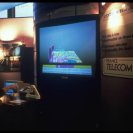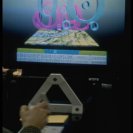During Imagina '93 computer graphics installations in Monte Carlo and in Karlsruhe were connected by modem through a conventional telephone line. Facing large video screens, the two distant players each shared the same virtual image space. While manipulating their own graphic elements each person was at the same time seeing on the screen in front of them the result of their distant partner's actions.
Each player could choose letters from a simulated keyboard on their screen. Using a multi-axis 3D mouse, the position, size and shape of each of these letters could be interactively manipulated over a rectangular plane that was divided like a game board into a grid of 64 squares. A map on surface of this game board showed Europe between Monte Carlo and Karlsruhe, representing the geographical distance between the two players.
Sharing a televirtual space of alphabetic forms, the formal interaction of the two players was both a sculptural interplay of the letters as well as a tentative communication with words. Up to eight letters could be placed by each player on the board at one time, and each player's letters had a distinctive colour (magenta and cyan). These letters could be individually resized in width, height and depth, becoming more transparent as their size increased. Each letter could also be moved anywhere over and above the surface of the game board. After some time, letters that were not being manipulated in one way or another would disappear from the game board area. Another function allowed each player to independently control their angle of view over the whole scene, and a voice phone connection between the two sites also allowed the players to speak to each other while manipulating these letters in the shared virtual space.
Credits:
Software: Gideon May









